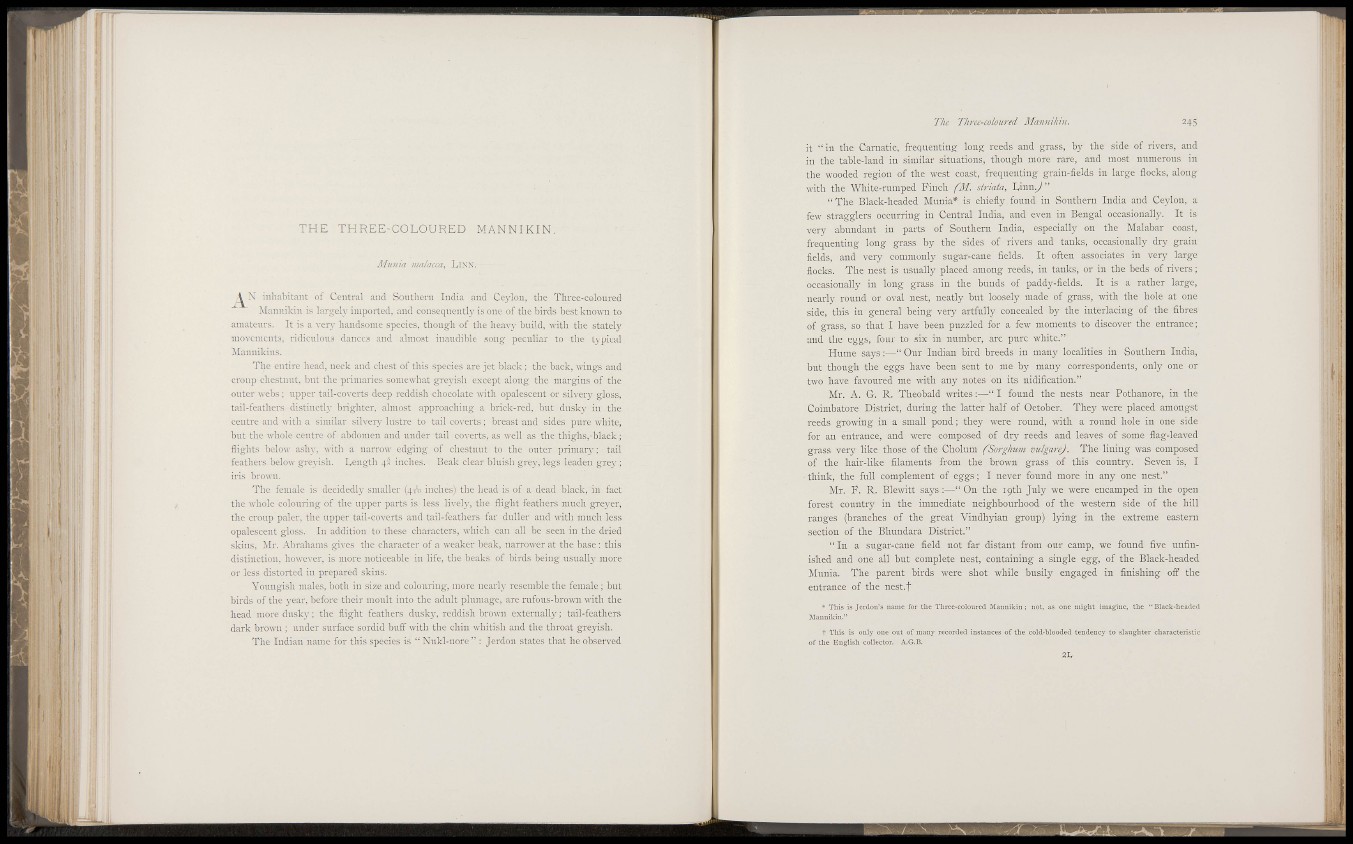
• s
f
i 538
ii
['I
M l . : i
I ' I :
i \ :
m .
THE THREE-COLOURED MANNIKIN.
iMunid iiialacca, Lixx.
^ M inhabitant of Central and Southern India and Ceylon, the Three-coloured
!\lauuikin is largely imported, and eonseqiienth' is one of the birds best known to
amateurs. It is a very handsome species, though of the heavy build, with the stately
movements, ridiculous dances and almost inaudible song peculiar to the typical
jMannildns.
The entire head, neck and chest of this species are jet black ; the back, wings and
croup chestnut, but the primaries somewhat greyish except along the margins of the
outer webs ; upper tail-coverts deep reddish chocolate Avith opalescent or silver}' gloss,
tailTeathers distinctly brighter, almost approaching a brick-red, but du.sky in the
centre and with a similar silvery lustre to tail coverts ; breast and sides pure white,
but the whole centre of abdomen and under tail coverts, as well as the thighs,• black ;
flights below ash\', A\-ith a narrow edging of chestnut to the outer primary ; tail
feathers below greyish. Length 4" inches. Beak clear bluish grey, legs leaden greA' ;
iris brown.
The female is decidedly smaller (4ÏU inches) the head is of a dead black, in fact
the whole colouring of the upper parts is less liveh", the flight feathers much grej-er,
the croup paler, the upper tail-coA'erts and tail-feathers far duller and with much less
opalescent gloss. In addition to these characters, which can all be seen in the dried
skins, ;Mr. Abrahams gi\'es the character of a weaker beak, narrower at the base : this
distinction, however, is more noticeable in life, the beaks of birds being nsnally more
or less distorted in prepared skins.
Youngish males, both in size and colouring, more nearly resend^le the female ; but
birds of the 3'ear, before their moult into the adidt plumage, are rufous-brown with the
head more dusky ; the flight feathers dusky, reddish brown externally ; tail-feathers
dark brown ; under surface sordid buff with the chin whitish and the throat greyish.
The Indian name for this species is " Nukl-nore " : Jerdon states that he observed
The Threc-coloured Mamiikin. 245
it "in the Carnatic, frecpienting long reeds and grass, by the side of rivers, and
in the table-land in similar situations, though more rare, and most numerous in
the wooded region of the west coast, frequenting grain-fields in large flocks, along
with the White-rumped Finch fM. striata, hum.J "
" T h e Black-headed Munia* is chiefly found in Southern India and Ceylon, a
few stragglers occurring in Central India, and even in Bengal occasionally. It is
very abundant in parts of Southern India, especially on the Malabar coast,
frequenting long grass by the sides of rivers and tanks, occasionally dry grain
fields, and very commonly sugar-cane fields. It often associates in very large
flocks. The nest is usually placed among reeds, in tanks, or in the beds of rivers ;
occasionally in long grass in the bunds of paddy-fields. It is a rather large,
nearly round or oval nest, neatly but loosely made of grass, with the hole at one
side, this in general being very artfully concealed by the interlacing of the fibres
of grass, so that I have been puzzled for a few moments to discover the entrance;
and the eggs, four to six in number, are pure white."
Hume says:—"Our Indian bird breeds in many localities in Southern India,
but though the eggs have been sent to me by many correspondents, only one or
two have favoured me with any notes on its nidification."
Mr. A. G. R. Theobald writes ;—" I found the nests near Pothanore, in the
Coimbatore District, during the latter half of October. They were placed amongst
reeds growing in a small pond; they were round, with a round hole in one side
for an entrance, and were composed of dry reeds and leaves of some flag-leaved
grass very like those of the Cholnm (Sorghum vulgarej. The lining was composed
of the hair-like filaments from the brown grass of this country. Seven is, I
think, the full complement of eggs ; I never found more in any one nest."
Mr. F. R. Blewitt says :—" On the 19th July we were encamped in the open
forest countrj' in the immediate neighbourhood of the western side of the hill
ranges (branches of the great Vindhyian group) lying in the extreme eastern
section of the Bhundara District."
" I n a sugar-cane field not far distant from our camp, we found five unfinished
and one all but complete nest, containing a single egg, of the Black-headed
Munia. The parent birds were shot while busily engaged in finishing off the
entrance of the nest.f
* Thi.s is Jcrdou's name for tlie Three-coloured Maiiuikin ; not, as one might imagine, the "Black-headed
Rlannikin."
t This is ouly one out of man)' recorded instances of the cold-blooded tendency to slaughter characteristic
of the F,ngli.sh collector. A.G.B.
21,
!
I is
i (>